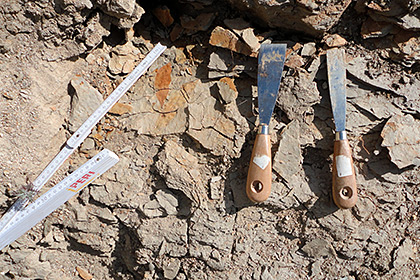Methods
NECLIME strongly encourages the use of quantitative paleoclimate and
paleoenvironmental reconstruction methods to enable multi-proxy comparisons
as well as validations of model studies. To achieve this goal, NECLIME
focuses on selected tools to facilitate large-scale analyses. In this
regard, NECLIME is also strongly interested in developing new and improving
well-established techniques.
The following methods are the basis of many research initiatives
within the NECLIME network.
Plant-based methods for climate quantification
Coexistence Approach
The Coexistence Approach is a method for quantitative
terrestrial paleoclimate reconstructions for Cenozoic paleobotanical records.
It is
based on the assumption fossil plant taxa have similar climatic
requirements as their nearest living relatives and can therefore
be extrapolated to
interpret past conditions. The aim of the Coexistence Approach
is to outline a climatic interval for a given fossil flora
and a selected climatic parameter,
in which all nearest living relatives of the fossil flora can
coexist. This method is suitable for all sorts of plant remains.
(Mosbrugger and Utescher 1997, Utescher et al. 2014)
CLAMP
- Climate Leaf Analysis Multivariate Program
CLAMP is a method of obtaining
ancient climate information from the architecture (physiognomy)
of fossil leaves of woody dicot flowering
plants. It is a multivariate statistical technique decoding
the climatic signal inherent in the physiognomy of leaves of
woody dicotyledonous plants.
CLAMP calibrates the numerical relations between leaf physiognomy
and meteorological parameters in modern terrestrial environments.
Using
this
calibration, past climatic data are potentially determinable
from leaf fossil assemblages provided that the calibration
is robust over time and
that the sampling of the fossil assemblage represents well
the characteristics of the living source vegetation.
(Wolfe 1990, Spicer et al. 2009)
More details here
Plant-based methods for vegetation quantification
PFT – Plant Functional Types
The PFT (Plant Functional Type)
Approach aims at reconstructing regional biomes using fossil
plant assemblages. The biomisation procedures
introduced by Prentice et al. (1996) and Ni et al. (2010) are
restricted to pollen data, whereas the approach of François et
al. (2011) can be applied to all plant organs. The assignment
of PFTs to fossil
taxa according to their botanical affinities allows for the
abstraction from taxonomy to universal plant traits. On this
basis, the PFT Approach
provides information on diversity of plant functional types
at each studied site, moreover, a likelihood level of presence,
as well as a
diversity index can be calculated (François et al. 2017). PFT
level vegetation reconstruction has the advantage of being
easily comparable with the results of vegetation models.
PCS – Plant Community Scenarios
Plant Community Scenarios (PCS) represent an approach for depicting
the quantitative representation of different taxa in fossil plant
assemblages
(mainly developed for carpological deposits), whose interpretation
is considered useful for vegetation reconstruction. Based on
relative
abundances
of taxa, the visualization uses pre-defined plant symbols
representing a group of taxa, which share the same leaf type
category, plant
habitus, and habitat to draw an image similar to transects
of extant vegetation with different ecological zones.
(Martinetto and Vassio 2010)
IPR – Integrated Plant Record vegetation analysis
The Integrated Plant
Record vegetation analysis (IPR-vegetation analysis) is a tool
for reconstructing zonal plant cover and palaeoenvironments
in the Cenozoic by integrating foliar, carpological and pollen
data. An internet platform provides open access to the IPR-database
and a calculation
tool to apply the analysis can be found online.
(Kovar-Eder
and Kvacek 2003, Teodoridis et al. 2011).
More
details here.
Earth system modelling
Modelling of past states of the Earth system is crucial to understand processes
behind patterns reconstructed from fossil proxy records. Moreover, the
possibility of validating the outputs obtained from paleo-modelling with
proxy data holds the key for assessing the reliability of anticipated
climate change scenarios. Following the standard of the IPCC, results
from multi-model approaches in the meantime have become available for
various Cenozoic time slices.
Since within the past two decades, NECLIME research brought about
a considerable repository of quantitative climate and vegetation data
for the continental Cenozoic, modelling has been in the focus of NECLIME
right from the beginning. Among others, various atmospheric modelling
studies have been conducted in the frame of the network (e.g. Steppuhn
et al. 2007; Micheels et al. 2011; Schneck et al. 2012). Another emphasis
was put on Neogene biome reconstructions using e.g. the CARAIB dynamic
vegetation model (e.g. François et al. 2017; Henrot et al. 2017) and vegetation
simulations using the DGVM LPJ-GUESS (Forrest et al. 2015). Moreover,
NECLIME members are involved in model inter-comparison projects such as
PlioMIP (e.g., Salzmann et al., 2013).
Definitions
To be considered for NECLIME publications
Definition of relevant botanical terms and vegetation units
by Johanna Kovar-Eder, Jean-Pierre Suc and Zlatko Kvacek (2008)
References
Forrest, M., Eronen, J.T., Utescher, T., Knorr, G., Stepanek, C., Lohmann, G., Hickler, T., 2015. Climate-vegetation modelling and fossil plant data suggest low atmospheric CO₂ in the late Miocene. Climate of the Past, 11, 1701 –1732. DOI 10.5194/cp-11-1701-2015
François, L., Bruch, A.A., Utescher, T., Spicer, R.A., Spicer, T., 2017. Reconstructing Cenozoic vegetation from proxy data and models – a NECLIME synthesis. Palaeogeography, Palaeoclimatology, Palaeoecology, 467, 1–286. DOI 10.1016/j.palaeo.2016.11.043
François, L., Utescher, T., Favre, E., Henrot, A.-J., Warnant, P., Micheels, A., Erdei, B., Suc, J.-P., Cheddadi, R., Mosbrugger, V., 2011. Modelling Late Miocene vegetation in Europe: Results of the CARAIB model and comparison with palaeovegetation data. Palaeogeography, Palaeoclimatology, Palaeoecology, 304, 359–378. DOI 10.1016/j.palaeo.2011.01.012
Henrot, A.-J., Utescher, T., Erdei, B., Dury, M., Hamon, N., Ramstein, G., Krapp, M., Herold, N., Goldner, A., Favre, E., Munhoven, G., François, L.M., 2017. Middle Miocene climate and vegetation models and their validation with proxy data. Palaeogeography, Palaeoclimatology, Palaeoecology, 467, 95–119. DOI 10.1016/j.palaeo.2016.05.026
Kovar-Eder, J., Kvacek, Z., 2003. Towards vegetation mapping based on the fossil plant record. Acta Universitatis Carolinae Geologica, 46, 7–13. pdf at researchgate
Martinetto, E., Vassio, E., 2010. Reconstructing “Plant Community Scenarios” by means of palaeocarpological data from the CENOFITA database, with an example from the Ca' Viettone site (Pliocene, Northern Italy). Quaternary International, 225, 25 –36. DOI 10.1016/j.quaint.2009.08.020
Micheels, A., Bruch, A. A., Eronen, J., Fortelius, M., Harzhauser, M., Utescher, T., Mosbrugger, V., 2011. Analysis of heat transport mechanisms from a Late Miocene model experiment with a fully-coupled atmosphere-ocean general circulation model. Palaeogeography, Palaeoclimatology, Palaeoecology, 304, 337 –350. DOI 10.1016/j.palaeo.2010.09.021
Mosbrugger, V., Utescher, T., 1997. The Coexistence Approach - a method for quantitative reconstructions of Tertiary terrestrial palaeoclimate data using plant fossils. Palaeogeography, Palaeoclimatology, Palaeoecology. 134, 61 –86. DOI 10.1016/S0031-0182(96)00154-X
Ni, J., Yu, G., Harrison, S.P., Prentice, I.C., 2010. Palaeovegetation in China during the late Quaternary: biome reconstructions based on a global scheme of plant functional types. Palaeogeography, Palaeoclimatology, Palaeoecology, 289, 44 –61. DOI 10.1016/j.palaeo.2010.02.008
Prentice, I.C., Guiot, J., Huntley, B., Jolly, D., Cheddadi, R., 1996. Reconstructing biomes from palaeoecological data: a general method and its application to European pollen data at 0 and 6 ka. Climate Dynamics, 12, 185 –194. DOI 10.1007/BF00211617
Salzmann, U., Dolan, A. M., Haywood, A. M., Chan, W. -L., Voss, J., Hill, D. J., … Zhang, Z., 2013. Challenges in quantifying Pliocene terrestrial warming revealed by data-model discord. Nature Climate Change, 3, 969-974.
Schneck, R., Micheels, A., Mosbrugger, V., 2012. Climate impact of high northern vegetation: Late Miocene and present. International Journal of Earth Sciences, 101, 323 –338. DOI 10.1007/s00531-011-0652-4
Spicer, R.A., Valdes, P.J., Spicer, T.E.V., Craggs, H.J., Srivastava, G., Mehrotra, R.C., Yang, J., 2009. New Developments in CLAMP: Calibration using global gridded meteorological data. Palaeogeography, Palaeoclimatology, Palaeoecology, 283, 91 –98. DOI 10.1016/j.palaeo.2009.09.009
Steppuhn, A., Micheels, A., Bruch, A.A., Uhl, D., Utescher, T., Mosbrugger, V., 2007. The sensitivity of ECHAM4/ML to a double CO₂ scenario for the Late Miocene and the comparison to terrestrial proxy data. Global and Planetary Change, 57, 189 –212. DOI 10.1016/j.gloplacha.2006.09.003
Teodoridis, V., Kovar-Eder, J., Mazouch, P. 2011. The IPR-vegetation analysis applied to modern vegetation in SE China and Japan. PALAIOS, 26, 623 –638. DOI 10.2110/palo.2010.p10-149r
Utescher, T., Bruch, A.A., Erdei, B., François, L., Ivanov, D., Jacques, F.M.B., Kern, A.K., Liu, Y.-S. (C.), Mosbrugger, V., Spicer, R.A., 2014. The Coexistence Approach—Theoretical background and practical considerations of using plant fossils for climate quantification. Palaeogeography, Palaeoclimatology, Palaeoecology, 410, 58–73. DOI 10.1016/j.palaeo.2014.05.031
Wolfe, J.A., 1990. Palaeobotanical
evidence for a marked temperature increase following the Cretaceous/Tertiary
boundary. Nature,
343, 153–156.
DOI 10.1038/343153a0

